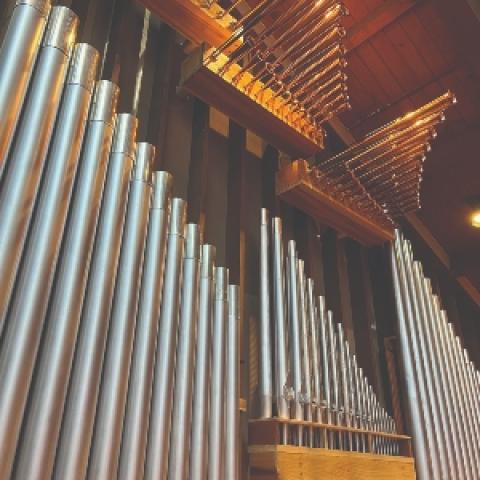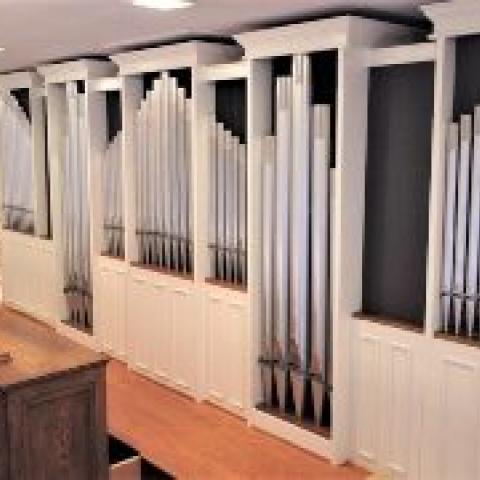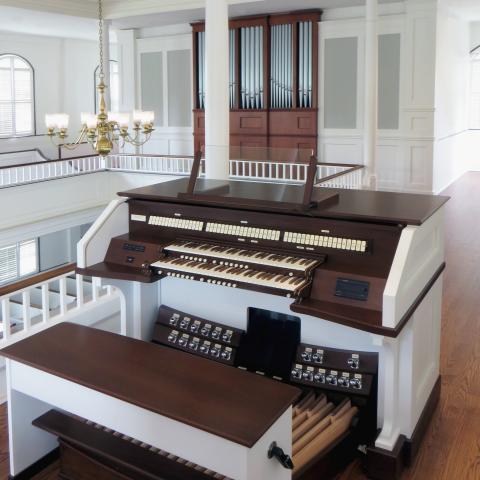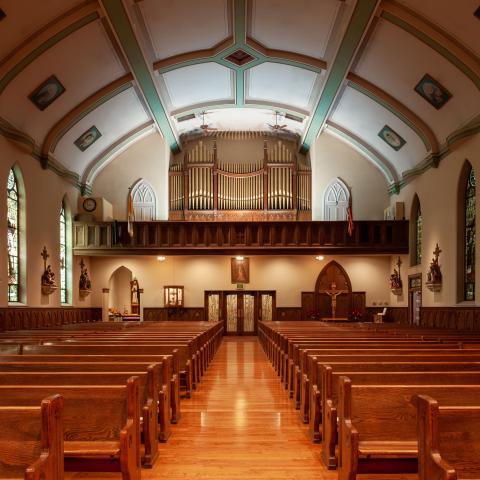
Marceau Pipe Organ Builders, Seattle, Washington
Saint Mary Magdalene Catholic Church, Everett, Washington
Marceau Pipe Organs has completed phase one of a new pipe organ for this Catholic parish. The church’s original instrument, built by Balcom & Vaughan of Seattle, had only six stops. During a major renovation of the nave, it was decided to invest in an instrument that would better serve the musical and liturgical needs for the many and varied services. Marceau Pipe Organ Builders was contracted to build this instrument.
In a time when the availability of good quality pipe organs is high, this presented an opportunity to explore those options. One such option came from Wenatchee, Washington, where a pipe organ from the First Presbyterian Church was available. The organ, originally built by M. P. Möller and augmented and enlarged by Balcom & Vaughan, was a good fit. The organ was transported to Everett where it became the basis for this project.
After a thorough examination of all the components, it was decided to utilize all the exposed Great pipes along with selected stops from the Swell. A recent addition to the Marceau inventory was a modest Balcom & Vaughan pipe organ, originally built for First Church of Christ, Scientist, on Mercer Island, Washington. The Swell division from that organ became the new Swell for Saint Mary Magdalene. Thus, the Swell utilizes windchests and much of the pipework from the B&V organ of Mercer Island, with three stops from the Möller. Given the physical layout of the organ, an enclosed Great was a natural choice, with the principal chorus of the Great in the center of the instrument.
The casework, consisting of two massive chambers, was milled and fabricated by Frans Bosman. Prior to the in-shop assembly, Bosman retired and returned to his homeland of the Netherlands. A recent addition to the Marceau staff was Randy Pettigrew, an experienced and multi-talented woodworker who oversaw the in-shop assembly and was present for the onsite installation. This was the first major casework project to come out of the shop in over twenty years.
The Pedal 16′ Subbass was chosen for the façade. The lowest twelve pipes are made of Philippine mahogany and the rest of the rank is of sugar pine. These two wood varieties provide a contrast to the red oak casework.
Tonally, the organ is designed to provide the musical resources for accompanying the church’s choir as well as supporting congregational singing. In the Swell, a complete flute chorus is provided that includes mutation stops at 22⁄3′ and 13⁄5′ pitches. The strings are reused from the Möller instrument and provide a sheen and shimmer befitting their orchestral flavor. The 8′ Hautbois is both assertive as a solo stop and demure enough to blend when a reed tone is needed. The 4′ Principal provides a much needed tuning stop and brings a cohesive blend to the Swell chorus.
The unenclosed Great of four stops comprises the 8′ Principal, 4′ Octave, 2′ Super Octave, and 11⁄3′ Mixture IV. This is the workhorse for congregational singing, providing a colorful and present sound throughout the entire nave. The façade for this division includes the low twelve pipes in flamed copper with the center section in polished tin. The flamed copper pipes were originally built by the Reuter Organ Company and were available during the early stages of this project. They provide a colorful focus to the center section of the organ case. The enclosed Great is prepared for future addition. It consists of two flutes (8′ Rohrflute and 4′ Spillflute), two strings (16′/8′ Dulciana and 8′ Dulciana Celeste), one principal (4′ Geigen), and one reed (16′/8′ Trumpet). The result is a tonal design that can provide two expressive divisions with color and contrast in the overall design.
Marceau Pipe Organ Builders
René Marceau
Sean Haley
Jim van Horn
Frans Bosman
Randy Pettigrew
GREAT (Manual I, partially enclosed)
16′ Dulciana (ext 8′)*4 12 pipes
8′ Principal (15 in façade)4 61 pipes
8′ Rohrflute*3 61 pipes
8′ Dulciana*4 61 pipes
8′ Dulciana Celeste (TC)*4 49 pipes
4′ Octave3 61 pipes
4′ Geigen*4 61 pipes
4′ Spillflute*3 61 pipes
2′ Super Octave3 61 pipes
1-1⁄3′ Mixture III–IV3 232 pipes
8′ Trumpet*4 61 pipes
16′ Swell to Great
8′ Swell to Great
* enclosed
SWELL (Manual II, enclosed)
16′ Gedecktbass (ext 8′)1 12 pipes
8′ Holzgedeckt1 61 pipes
8′ Gambe1 61 pipes
8′ Gambe Celeste (GG)1 54 pipes
4′ Principal2 61 pipes
4′ Koppelflute2 61 pipes
4′ Gambe (ext 8′)1 12 pipes
4′ Gambe Celeste (ext 8′)1 7 pipes
2-2⁄3′ Nasat2 61 pipes
2′ Octave (ext 4′)2 12 pipes
2′ Blockflute2 61 pipes
1-3⁄5′ Tierce2 61 pipes
1-1⁄3′ Quintflute (ext 2-2⁄3′)2 12 pipes
8′ Hautbois1 61 pipes
8′ Trumpet (Gt)4
Tremulant
16′ Swell to Swell
PEDAL
32′ Resultant (fr 16′ Subbass)
16′ Subbass2 32 pipes
16′ Gedecktbass (Sw 16′)1
16′ Dulciana (Gt 16′)4
8′ Principal (Gt 8′)4
8′ Rohrflute (Gt 8′)3
8′ Dulciana (Gt 8′)4
4′ Principal (Gt 8′)4
4′ Spillflute (Gt 4′)3
16′ Posaune (ext Gt 8′)4 12 pipes
8′ Trumpet (Gt 8′)4
4′ Clarion (Gt 8′)4
8′ Great to Pedal
8′ Swell to Pedal
20 stops, 24 ranks, 1,403 pipes
1 – 1952 M. P. Möller Opus 8315
2 – 1977 Balcom & Vaughan Opus 827
3 – 1984 Balcom & Vaughan Opus 861
4 – 2022 Marceau Opus 41







